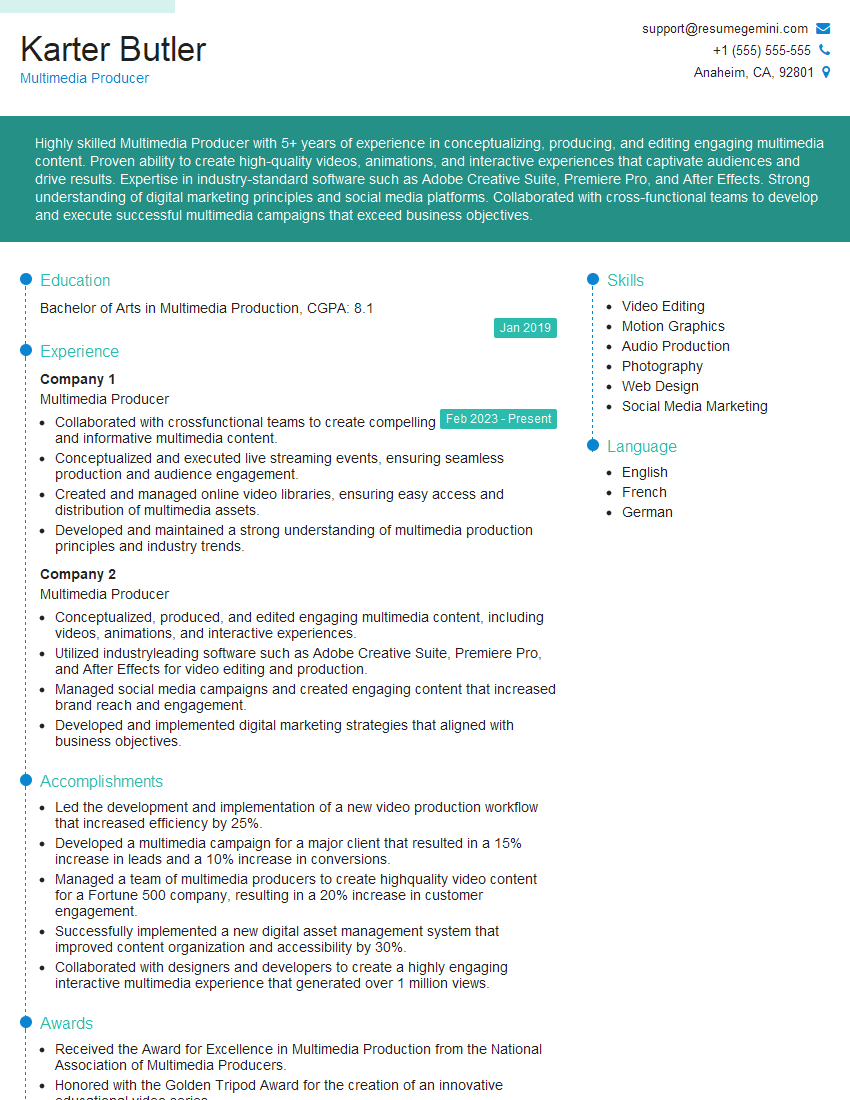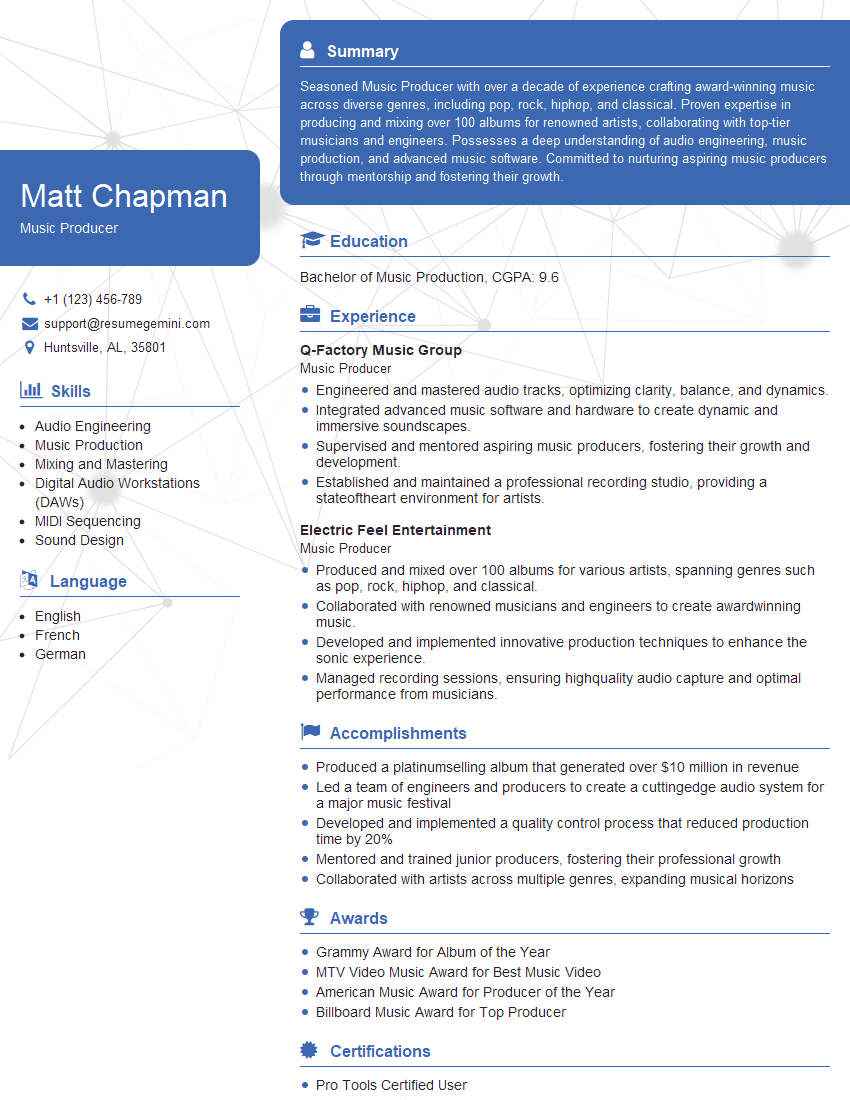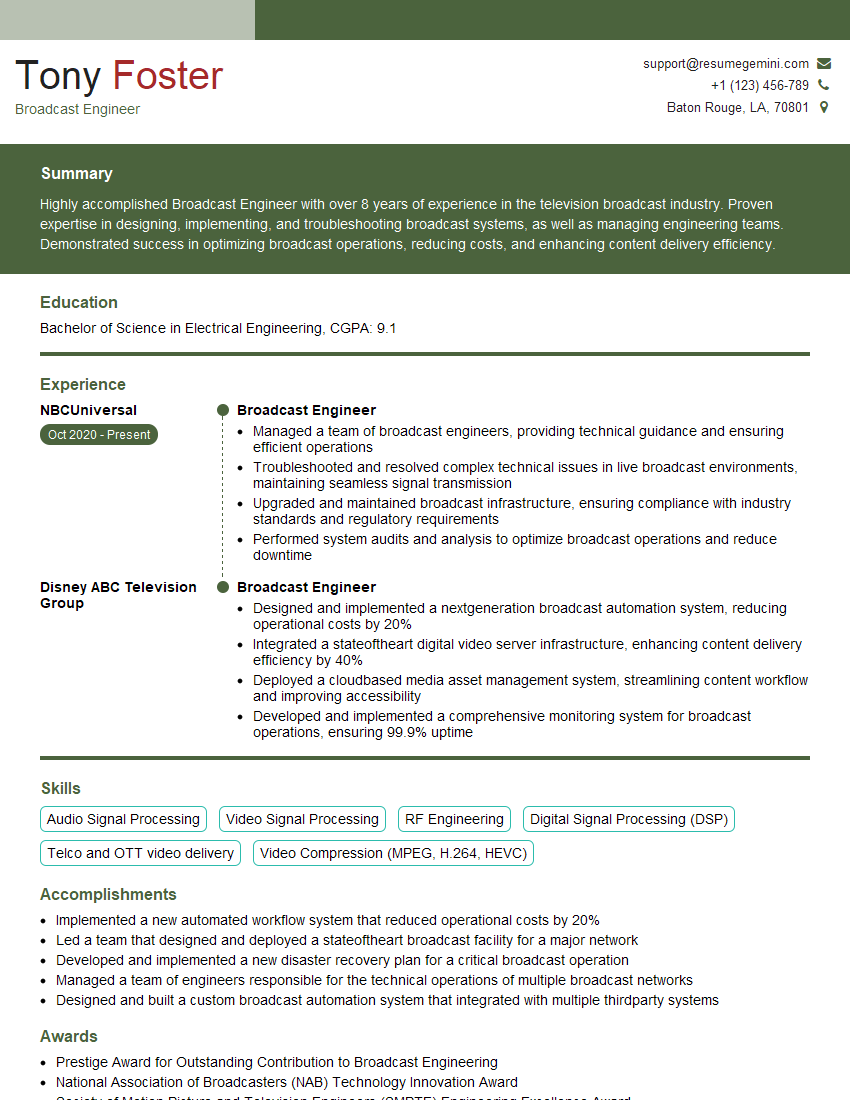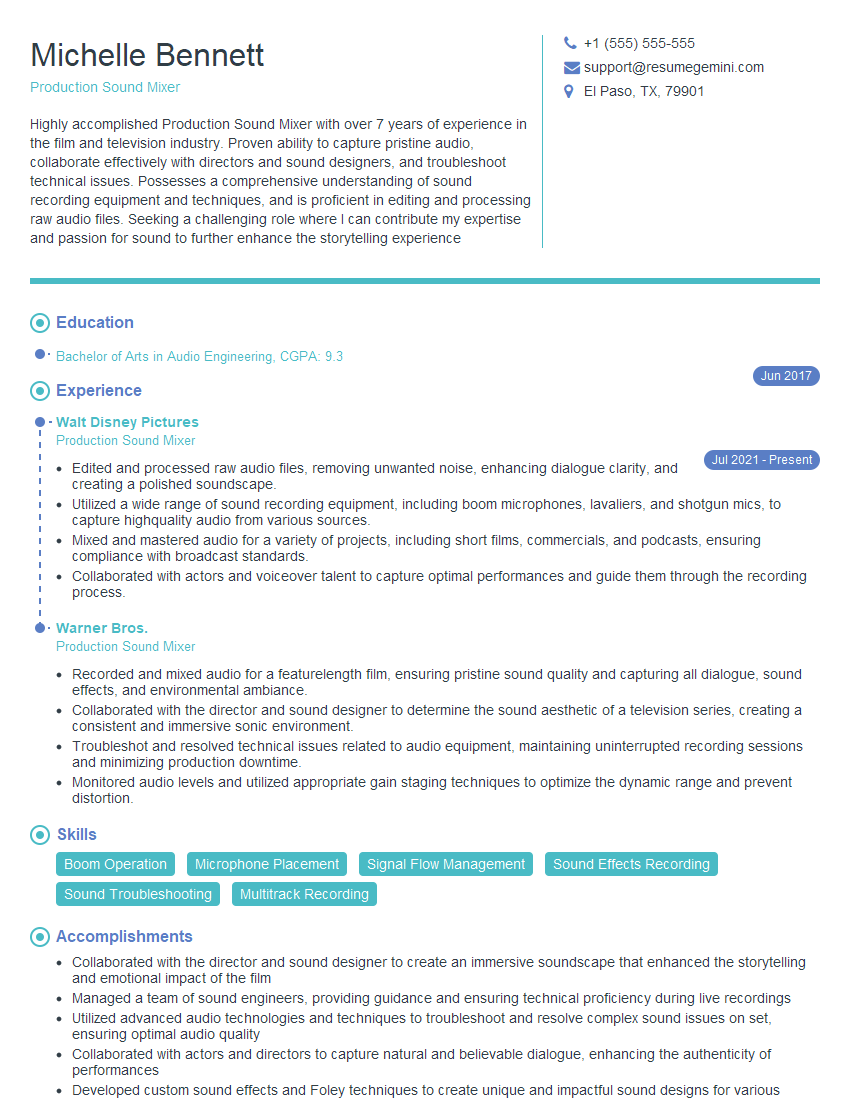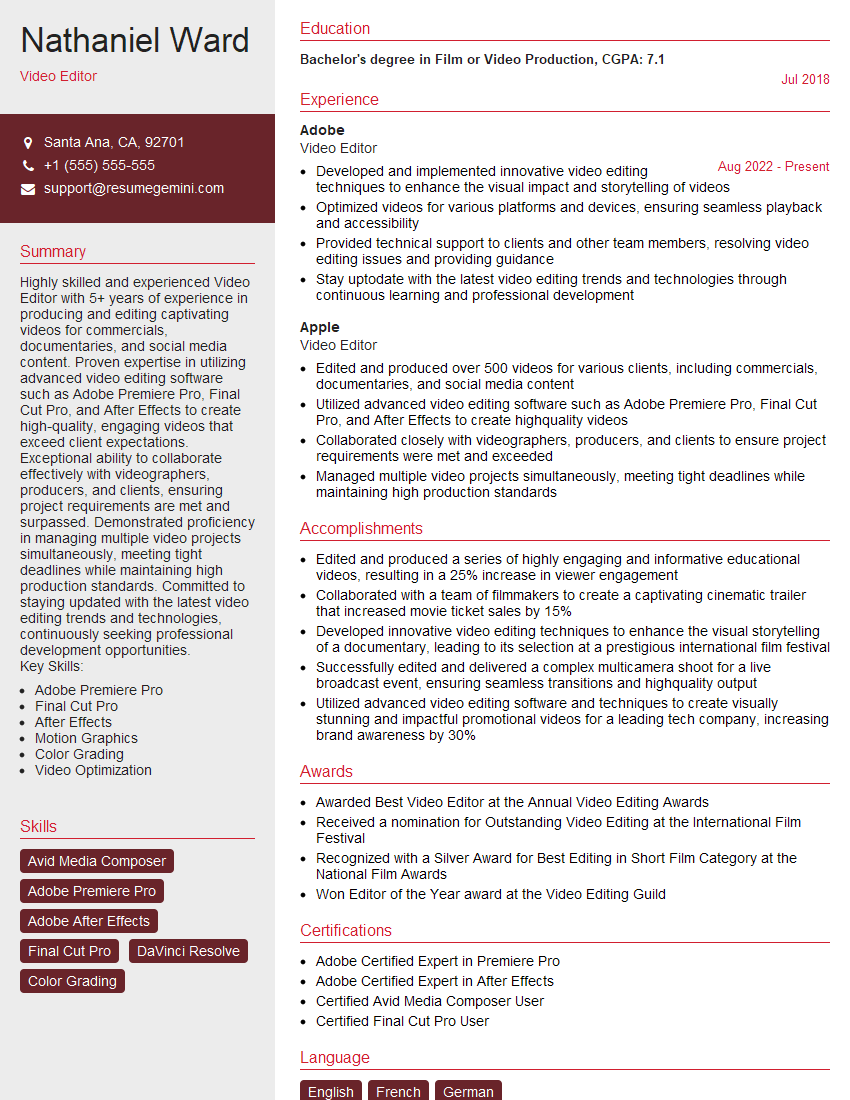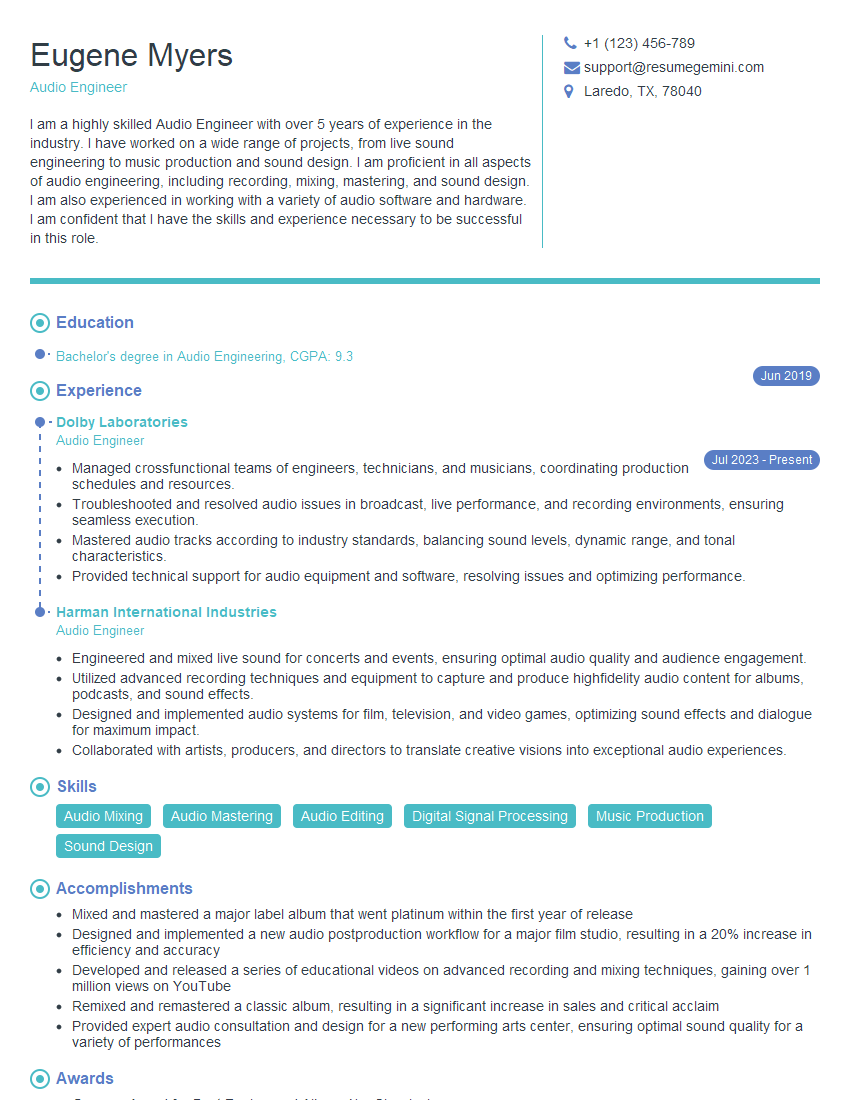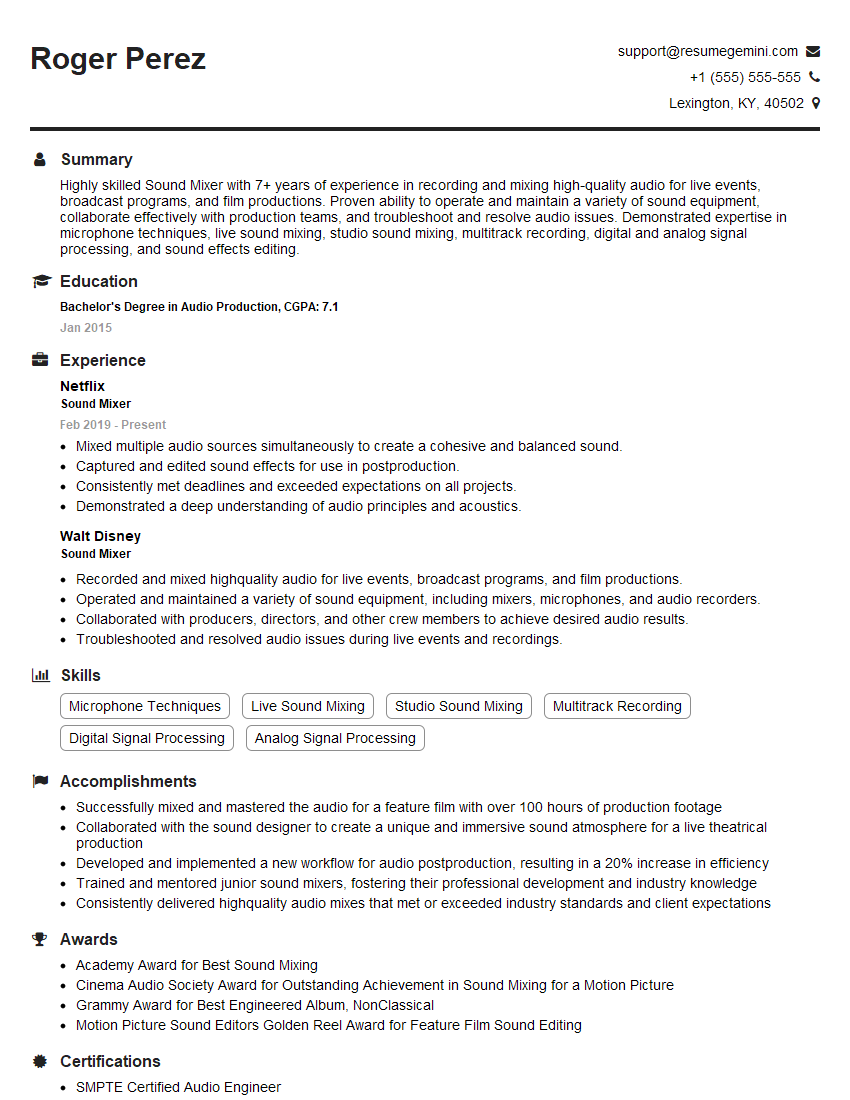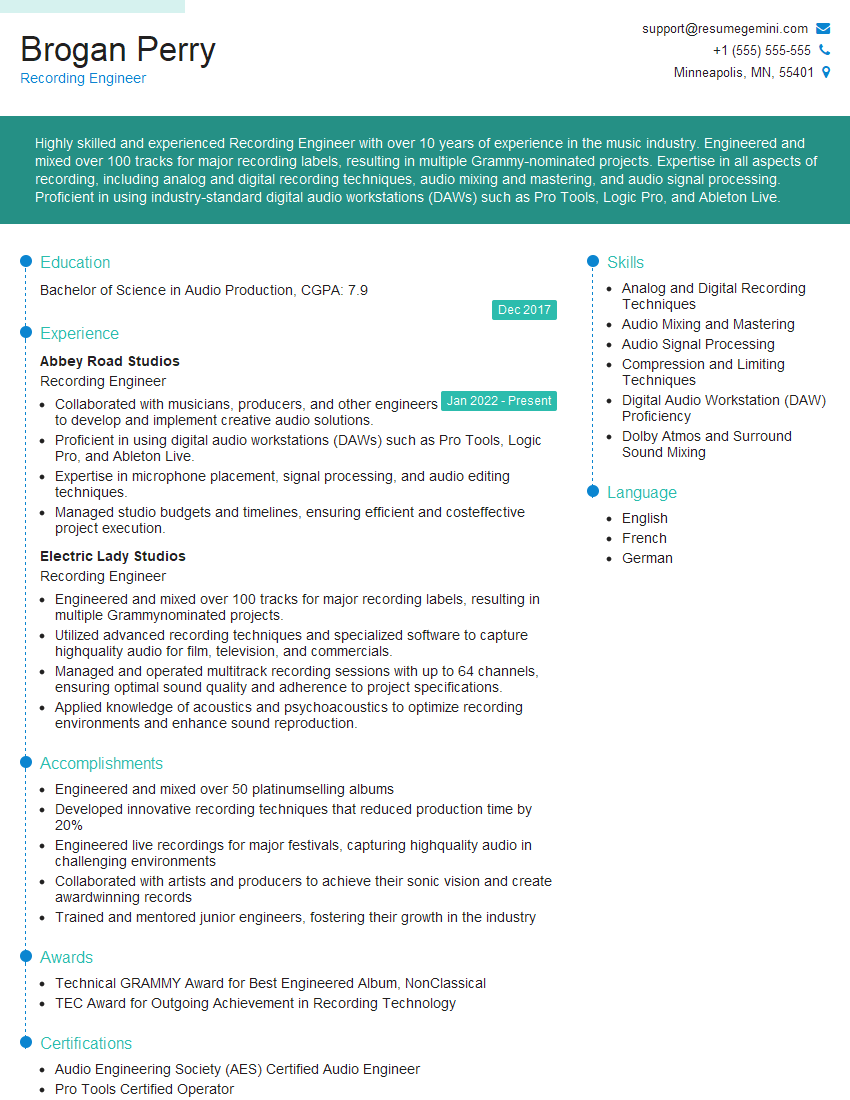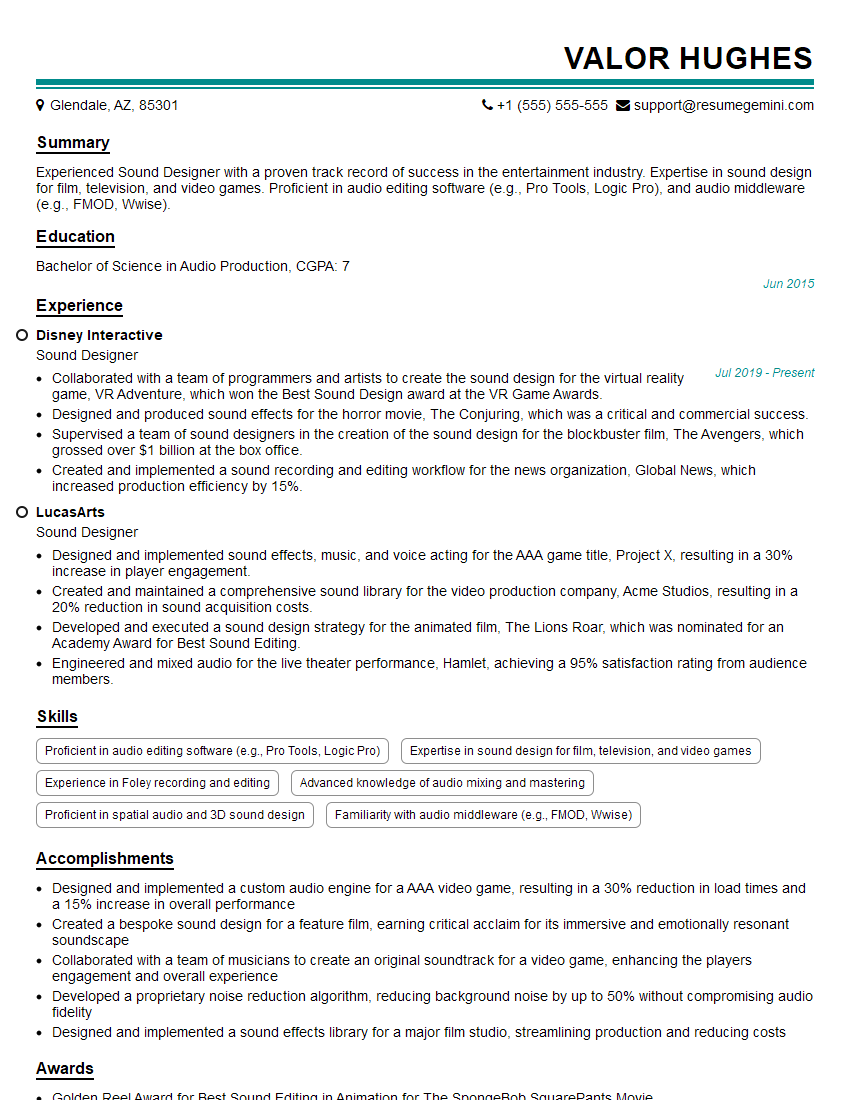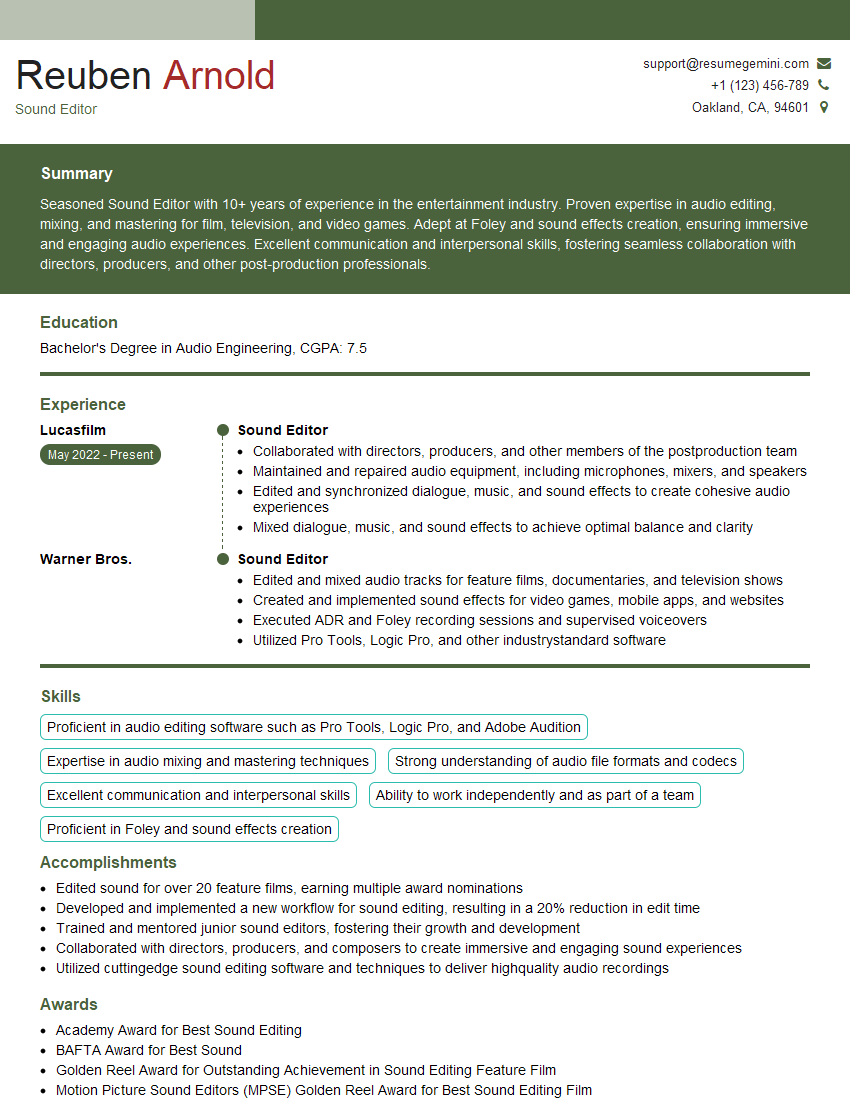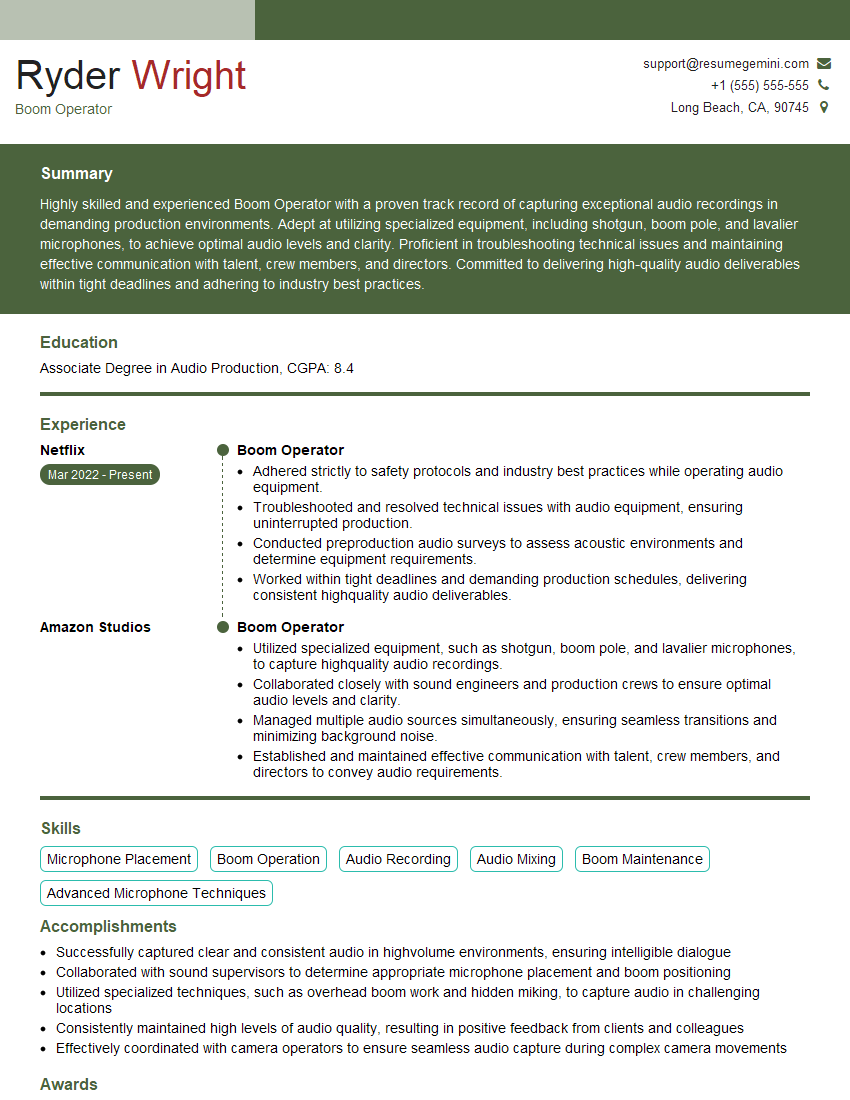Interviews are opportunities to demonstrate your expertise, and this guide is here to help you shine. Explore the essential Stereo Microphone Placement interview questions that employers frequently ask, paired with strategies for crafting responses that set you apart from the competition.
Questions Asked in Stereo Microphone Placement Interview
Q 1. Explain the concept of stereo imaging in audio recording.
Stereo imaging in audio recording refers to the creation of a realistic and spatially accurate soundstage, allowing listeners to perceive the location of individual instruments or sound sources within the recording. It’s like creating a virtual snapshot of the acoustic environment. Instead of hearing a flat, mono sound, you get a sense of depth and width. Imagine listening to a live orchestra – you can hear the violins to the left, the trumpets in the center, and the cymbals off to the right. Stereo imaging strives to replicate this experience.
Achieving good stereo imaging involves careful microphone placement and technique. Different techniques create different spatial characteristics, each with its own strengths and weaknesses. A well-imaged recording provides a captivating and immersive listening experience.
Q 2. Describe the XY stereo microphone technique. What are its advantages and disadvantages?
The XY stereo technique is one of the simplest and most common methods for creating a stereo image. It involves placing two cardioid or hypercardioid microphones very close together, typically at a 90° or 120° angle, pointing towards the sound source. The closer the microphones, the narrower the stereo image will be. The signal from both microphones is then recorded simultaneously.
- Advantages: Relatively simple setup, avoids phase cancellation issues (common with spaced-pair techniques), provides a good sense of width, and is excellent for close-miking.
- Disadvantages: Can lack the depth and spaciousness of other techniques, especially with wide sound sources; can be less suitable for recording reverberant environments where a wider spread of microphones might capture a more ambient sound.
Imagine recording a small vocal ensemble. XY works well because the microphones are close enough to capture the ensemble’s overall sound coherently without excessive phase issues. However, for a large orchestra in a concert hall, a more spaced-pair technique would likely provide a wider and more detailed stereo image.
Q 3. Compare and contrast the XY, ORTF, and MS stereo microphone techniques.
Let’s compare XY, ORTF, and MS stereo microphone techniques:
- XY: Two cardioid or hypercardioid mics close together (90-120° angle). Simple setup, minimal phase issues, good width but potentially lacking depth.
- ORTF: Two cardioid mics spaced 17cm apart at a 110° angle. Balances width and depth, less prone to phase cancellation than spaced-pair techniques but more susceptible than XY.
- MS (Mid-Side): Uses one cardioid (Mid) mic for the mono signal and one figure-8 (Side) mic for the stereo information. Offers considerable control over the stereo width in post-production, excellent for creating a wider image, and can capture more ambiance, but requires more complex processing.
The choice depends on the recording situation. XY is great for simplicity, ORTF strikes a balance, and MS gives you extensive post-production control. If I’m recording a singer-songwriter in a treated room, XY might suffice. For a symphony orchestra, I’d likely choose MS to control the amount of ambience in the stereo image.
Q 4. What are the factors to consider when choosing a stereo microphone technique for a specific recording environment?
Choosing the right stereo technique depends on several factors:
- Sound Source Size and Location: A small, tightly clustered ensemble benefits from XY, while a large orchestra might need ORTF or MS for better spatial representation.
- Room Acoustics: In a highly reverberant space, MS allows for better control over the amount of ambience included in the recording. In a dry space, XY may be preferred.
- Desired Stereo Width: XY provides a relatively narrow stereo image, while MS allows for greater width control in post-production. ORTF sits in between.
- Technical Skills and Equipment: MS requires more post-processing knowledge and capabilities than XY or ORTF.
- Microphone Characteristics: Different microphone polar patterns (cardioid, hypercardioid, figure-8) will affect the captured sound and stereo image differently.
For instance, recording a solo acoustic guitar in a small, untreated room may benefit from an XY configuration with small-diaphragm condenser mics. Recording a full band in a large, reverberant space would likely call for a more sophisticated approach like MS with large-diaphragm condenser mics.
Q 5. How does room acoustics affect stereo microphone placement?
Room acoustics significantly impact stereo microphone placement and the resulting stereo image. Reflections from walls, ceilings, and floors can add coloration, reverb, and potentially phase cancellation issues to the recording. A highly reverberant space can wash out the stereo image, making it less distinct. A dry, untreated space may lack depth and natural ambience.
Careful consideration of microphone placement is key. You might want to experiment with different microphone positions to find the sweet spot that minimizes unwanted reflections and maximizes the desired stereo characteristics. Diffusers or absorbers could be used to control the room’s acoustics for better results.
For example, if recording in a live room, the proximity effect (bass boost from close proximity to a microphone) and reverberation could become more prominent. An experienced engineer might carefully position microphones to balance direct and reflected sound, or utilize specialized techniques to control the reverberation.
Q 6. Explain the importance of phase coherence in stereo recordings.
Phase coherence is crucial in stereo recordings because it directly affects the perceived location and clarity of instruments. Phase refers to the timing relationship between the sound waves arriving at each microphone. When sounds arrive at both microphones in phase (at the same time or with a consistent time difference), they add up constructively, creating a fuller, more natural sound.
When sounds are out of phase, the waves interfere destructively, leading to phase cancellation—a reduction in volume or even complete cancellation of certain frequencies. This results in a thin, unnatural, or ‘hollow’ sound. Poor phase coherence can negatively impact the perceived stereo image, creating holes in the soundstage or making instruments seem to disappear. Maintaining phase coherence is crucial for a cohesive and realistic recording.
Q 7. How would you address phase cancellation issues in a stereo recording?
Addressing phase cancellation issues involves several strategies:
- Careful Microphone Placement: The XY technique inherently minimizes phase cancellation. Using techniques like ORTF or MS can help too, depending on the recording environment.
- Minimize Spaced-Pair Techniques in Reverberant Environments: Spaced-pair techniques, while often creating a wider image, are more susceptible to phase cancellation problems in rooms with a lot of reverb.
- Post-Production Techniques: In some cases, phase cancellation can be partially corrected using digital audio workstations (DAWs). Techniques like phase alignment or mid-side processing can help. However, it’s far better to prevent phase cancellation during recording than to try to fix it afterwards.
- Experimentation and Monitoring: Listen critically to the recording while experimenting with different microphone positions and techniques to find the ideal setup for phase coherence.
For example, if you’re using a spaced-pair setup and notice a thin or hollow sound in the recording, try moving the microphones closer together, using a different microphone technique (XY, ORTF, or MS), adjusting the microphone’s polar patterns to reduce unwanted sounds, or adding acoustic treatment to the room to reduce reverberation.
Q 8. Describe the challenges of recording stereo in a reverberant space.
Recording stereo in a reverberant space presents significant challenges primarily because the reflections from the surrounding surfaces interfere with the direct sound reaching the microphones. This interference leads to a muddy, less defined sound, blurring the stereo image and masking the detail. Imagine trying to hear a conversation clearly in a large, empty cathedral; the echoes make it difficult to distinguish individual voices.
These reflections arrive at the microphones at different times, creating phase cancellations and comb filtering effects (discussed further in the next question), diminishing the clarity and precision of the stereo recording. The reverberation also reduces the perceived intimacy of the sound source, making it sound distant and less present.
To mitigate these issues, careful microphone placement and techniques like using directional microphones, employing close miking, and utilizing sound treatment to control the reverberation are crucial.
Q 9. What techniques can be used to minimize comb filtering in stereo recordings?
Comb filtering is a phenomenon that occurs when two similar signals arrive at a microphone with a slight time delay, creating a pattern of cancellations and reinforcements in the frequency spectrum. Think of it like waves interfering with each other; sometimes they build up, sometimes they cancel out. In stereo recording, this often happens when the signals from two microphones arrive slightly out of sync, due to their spacing.
Several techniques minimize comb filtering:
- Minimize Microphone Spacing: Reducing the distance between the microphones decreases the time delay between arriving signals, thus reducing comb filtering. However, excessively close spacing can lead to a narrow stereo image.
- Use Cardioid or Hypercardioid Microphones: Directional microphones with a narrower pickup pattern can better isolate the direct sound from the reflections, reducing the chances of unwanted phase cancellation. Their rejection of off-axis sound minimizes the chances of time-delayed sounds reaching the microphones.
- Appropriate Microphone Placement: Carefully positioning the microphones to create a balanced stereo image is crucial. Techniques like XY, ORTF, and MS (Mid-Side) offer different solutions to manage phase issues, each with their respective trade-offs. (Further described in question 5.)
- Digital Signal Processing (DSP): Post-production techniques like equalization (EQ) and careful application of reverb/delay plugins can help to subtly address the comb filtering issues. It’s best to minimize the problem at the source, however.
Q 10. How do you determine the optimal distance between the microphones and the sound source?
The optimal distance between microphones and the sound source depends heavily on the desired sonic characteristics. This is not a one-size-fits-all answer but a balance of factors.
Close Miking (a few centimeters to a few inches): This technique emphasizes the direct sound, minimizing room reflections and yielding a more intimate, detailed, and dry sound. Useful for isolating specific instruments or capturing close-up details.
Mid-Range Miking (a few feet to several feet): This approach incorporates a balance of direct and reflected sound, offering a more natural feel and room ambiance. Common in recording acoustic instruments, allowing some natural ambience and spaciousness.
Distant Miking (several feet or more): This captures a larger sound field, more room ambience, and reverberation. It’s often used to create a large, spacious soundscape but could also be used as an additional layer for texture.
Factors to consider include the acoustic properties of the space, the directivity of the microphone, the sound source’s character, and the desired balance between direct sound and ambience. Experimentation and critical listening are key!
Q 11. Explain the concept of phantom power and its relevance to stereo microphone placement.
Phantom power is a method of supplying electrical power to condenser microphones over the same cable that carries the audio signal. It’s crucial for stereo microphone placement because most condenser microphones, known for their high sensitivity and detail, rely on phantom power to operate. They cannot function without it.
In a stereo recording setup, both microphones, if they are condenser microphones, will need phantom power. This is usually supplied by the audio interface or mixer. It’s essential to ensure that the phantom power switch is activated in the correct channel corresponding to the microphones. Failing to do so will result in a silent recording. It’s always crucial to double-check your equipment before recording.
Q 12. What are the different types of stereo microphone configurations?
Several stereo microphone configurations exist, each with its own advantages and disadvantages:
- XY (Coincident): Microphones are placed very close together at a specified angle (typically 90° or 135°). This provides a very narrow stereo image with minimal phase cancellation issues, commonly used for close miking.
- ORTF (Near-Coincident): Microphones are slightly spaced apart (17cm or 6.7 inches) at a 110° angle. It provides a wider stereo image compared to XY, maintaining a good balance of stereo width and phase coherence.
- Mid-Side (MS): Employs a mid (mono) microphone capturing the center signal and a side (stereo) microphone capturing the left-right difference. This provides flexibility in post-production, allowing for adjustments to stereo width by changing the balance of the mid and side signals. This offers very precise control of the image.
- AB (spaced pair): Microphones are spaced farther apart (1-2 meters or more) usually pointing directly at the source. This technique provides a very wide stereo image but is more prone to phase cancellation and comb filtering, requiring careful positioning and acoustic considerations.
The choice of configuration depends on the recording situation, the desired stereo image width, and the tolerance for comb filtering.
Q 13. How does microphone directionality impact stereo imaging?
Microphone directionality significantly impacts stereo imaging. Directionality refers to the microphone’s sensitivity to sound from different directions. A cardioid microphone, for example, is most sensitive to sound arriving from the front while rejecting sound from the rear. Omnidirectional microphones, however, pick up sound equally from all directions.
Using highly directional microphones (like hypercardioids) in a spaced-pair configuration can lead to a wider stereo image with better separation between instruments. However, there is higher potential for comb filtering. Less-directional microphones (like omni-directional or wide cardioid) create a narrower stereo image but with less chance of comb filtering.
The interaction between microphone directivity and placement is critical. For instance, using two cardioid microphones in an XY configuration will result in a narrower stereo image compared to using the same microphones spaced widely apart (AB). Understanding the microphone’s polar pattern (diagram of its sensitivity to sound from different directions) is key to making informed choices about placement for stereo imaging.
Q 14. Describe how to achieve a wide stereo image.
Achieving a wide stereo image involves a combination of microphone placement techniques, microphone selection, and careful consideration of the recording environment.
- Spaced Pair (AB): This is the most straightforward method. Place two microphones significantly apart (several feet or meters), pointing towards the sound source. The wider the spacing, the wider the stereo image; however, as mentioned, be mindful of increased susceptibility to comb filtering.
- MS Stereo: This technique offers excellent control. Adjust the balance between the mid and side channels in post-production to dial in the ideal width. A small amount of side signal produces a narrower image; larger amounts create a wider image.
- Microphone Choice: Omni-directional or wide cardioid microphones can be used for a wide stereo image with reduced comb filtering in the XY or ORTF configurations; they capture sound from a broader area which assists in producing a larger-sounding stereo field.
- Room Acoustics: A more reverberant space will naturally contribute to a wider stereo image, but this has to be managed carefully to avoid masking detail and causing muddiness. Controlled reverberation through acoustic treatment can enhance this effect without creating unwanted artifacts.
- Post-Production Processing: Careful processing and widening effects can help expand the stereo image. However, overuse can result in an unnatural and artificial sound.
The best approach depends on the recording environment and the desired outcome. Experimentation is paramount; listen critically to find the optimal balance between width and clarity.
Q 15. Describe how to achieve a narrow stereo image.
Achieving a narrow stereo image means creating a recording where the sound sources are perceived as being closely grouped together, with minimal width or spaciousness in the stereo field. Think of it like a spotlight on the performance, rather than a wide-angle lens.
This is primarily achieved by placing the microphones closely together. Coincident techniques, like the XY or Blumlein configurations, are excellent choices. In XY, two cardioid microphones are positioned at a 90-degree angle, minimizing the differences in arrival time and phase between the microphones, leading to a tight, focused image. Blumlein uses figure-of-eight microphones at a 90-degree angle, providing a similar effect but potentially with a slightly different tonal balance.
The closer the microphones are, the narrower the stereo image. However, extreme proximity might lead to phase cancellation issues, so finding the optimal balance is key. Experimentation is crucial; the room acoustics also impact the perceived width. A highly reverberant space will inherently widen the image, even with closely spaced mics. Minimizing reflections through strategic mic placement and room treatment is helpful in keeping the image tight.
Career Expert Tips:
- Ace those interviews! Prepare effectively by reviewing the Top 50 Most Common Interview Questions on ResumeGemini.
- Navigate your job search with confidence! Explore a wide range of Career Tips on ResumeGemini. Learn about common challenges and recommendations to overcome them.
- Craft the perfect resume! Master the Art of Resume Writing with ResumeGemini’s guide. Showcase your unique qualifications and achievements effectively.
- Don’t miss out on holiday savings! Build your dream resume with ResumeGemini’s ATS optimized templates.
Q 16. What are some common problems encountered during stereo microphone placement?
Common problems in stereo microphone placement often stem from poor understanding of phase cancellation, comb filtering, and room acoustics. Phase cancellation occurs when sound waves from a source arrive at the microphones out of phase, resulting in a loss of signal. This is more pronounced with spaced pairs and low frequencies.
- Phase Cancellation: Spaced microphones can pick up the same sound wave at different times, causing destructive interference. This manifests as a thin or hollow sound, especially in the bass frequencies.
- Comb Filtering: This arises from multiple reflections of the sound reaching the microphones at different times, producing a ‘comb-like’ effect in the frequency response, resulting in uneven sound.
- Room Acoustics: Reverberation and reflections from room surfaces can severely color the stereo image, making it sound muddled or unnatural. A poorly treated room will often lead to an excessively wide or uneven image.
- Incorrect Microphone Spacing and Orientation: Using improper angles or distances can lead to unwanted phasing issues or a skewed perspective of the sound stage.
Careful planning, including pre-recordings to check for issues, is essential to avoid these problems.
Q 17. How would you troubleshoot a stereo recording with poor stereo separation?
Troubleshooting poor stereo separation starts with analyzing the recording itself and evaluating the placement choices made.
- Listen Critically: Identify precisely which elements lack separation. Is the image too narrow, too wide, or unevenly distributed?
- Check Phase Correlation: Analyze the waveforms of the left and right channels. Significant similarities indicate phase cancellation, suggesting too-close microphone placement or issues with room reflections.
- Review Microphone Placement: Re-evaluate the chosen technique (XY, ORTF, etc.) and spacing. Was it appropriate for the acoustic environment and the desired stereo width? Excessive spacing usually leads to poor separation at low frequencies, but poor high-frequency separation suggests other issues.
- Assess Room Acoustics: If the room is highly reverberant, reflections might smear the stereo image. Consider using room treatment or re-positioning the microphones to minimize the effect of reflections.
- Experiment with Microphone Technique: If using a spaced pair, consider switching to a coincident pair, or vice versa. Slight adjustments to mic angle or distance can greatly impact separation.
- EQ and Processing: In post-production, subtle EQ adjustments or careful stereo widening plugins can partially correct small separation problems, but these should not be relied on to fix issues arising from poor initial microphone placement.
Often, a combination of these steps will lead to the root of the problem. Remember that starting with good microphone placement is far superior to fixing issues in post-production.
Q 18. What are the advantages of using coincident microphone pairs?
Coincident microphone pairs, where both microphones share the same acoustic center point, offer several advantages:
- Minimal Phase Cancellation: Since both microphones receive the sound essentially simultaneously, phase problems are minimized, producing a cleaner, more precise stereo image, particularly in the low frequencies.
- Natural Stereo Image: The resulting image tends to be more natural and less prone to artificial widening effects often associated with spaced pairs.
- Easier to Use: Setting up and aligning coincident pairs is often simpler than setting up spaced pairs.
- Less Susceptible to Room Reflections: The close proximity reduces the impact of early reflections.
Examples include XY (cardioid mics at 90 degrees) and Blumlein (figure-8 mics at 90 degrees) configurations. These methods are popular for recording instruments and vocals where a tightly focused and natural sound is preferred.
Q 19. What are the advantages of using spaced microphone pairs?
Spaced microphone pairs, where the microphones are placed further apart, create a wider stereo image capturing more of the acoustic environment. This approach introduces a perspective of the sound field that is not possible with coincident techniques.
- Wider Stereo Image: The primary advantage is their ability to create a broader, more spacious and immersive soundstage, excellent for capturing ambient sounds and the natural width of ensembles.
- Enhanced Localization: The spaced arrangement improves the ability to locate individual instruments within the stereo field.
- Better Reproduction of Acoustic Space: It captures more of the room’s ambience and reverberation, enhancing the realism and sense of space.
However, spaced pairs can be more susceptible to phase cancellation and comb filtering effects, especially at lower frequencies. Careful placement and consideration of the room’s acoustics are paramount. The ORTF and NOS techniques are examples of spaced microphone techniques, best suited for situations where a wider, more spacious feel is desired. These methods are great for recordings of orchestras, choirs, or large ensembles.
Q 20. How does microphone capsule type affect stereo imaging?
The type of microphone capsule significantly impacts stereo imaging. Different polar patterns (cardioid, omni, figure-of-eight) influence the sound capture and thus the width and tonal balance of the stereo image.
- Cardioid: Cardioid microphones are directional, focusing on sounds directly in front of the capsule, reducing background noise and providing a more focused stereo image. Often used in XY and ORTF configurations.
- Omni-directional: Omni-directional capsules capture sound equally from all directions. When used in a coincident pair, they can create a more natural but potentially less defined stereo image, more susceptible to room reflections. Using omni mics with spaced pairs can lead to increased width and ambience.
- Figure-of-Eight: Figure-of-eight microphones are bidirectional; they capture sound equally from the front and back, rejecting sound from the sides. Blumlein pairs are a good example. This can give a more balanced and detailed stereo image, particularly with its inherent cancellation of sounds from the sides, helping to isolate the stereo source.
The choice of capsule depends greatly on the recording environment and the desired result. Experimentation with different capsule types is encouraged to fully explore their impact on the final stereo image.
Q 21. How would you adapt your stereo microphone placement for recording a choir?
Recording a choir requires careful consideration of the choir’s size and the desired sonic characteristics. A spaced pair technique is typically preferred to capture the breadth of the choir.
For a large choir, a spaced pair with omni or wide-cardioid microphones is often suitable. These microphones are spread across the front of the choir to capture the whole soundstage and provide the listener with a sense of depth. The distance between the microphones is determined by the size of the choir, with larger choirs demanding greater separation.
For a smaller choir, an ORTF or similar spaced arrangement with cardioid microphones can still provide a wide image, but offers more controlled background capture.
To avoid phase cancellation issues, ensuring the microphones are adequately spaced and taking advantage of the natural reverberation of the room (if desirable) is important. The placement should reflect the shape of the choir—curved or linear—to capture the entire group evenly. The microphones need to be positioned far enough to avoid overloading and create a natural stereo image. Pre-testing is highly recommended to find the sweet spot, balancing the width and clarity of the recording.
Q 22. How would you adapt your stereo microphone placement for recording a string quartet?
Recording a string quartet requires capturing the individual instruments while maintaining a cohesive ensemble sound. A common approach is the Decca Tree technique, using three spaced omni-directional or cardioid microphones forming an equilateral triangle above and slightly in front of the quartet. This captures a natural balance and spaciousness. Alternatively, a spaced pair technique with two cardioid microphones can be used, angling them to pick up the quartet. The distance and angle depend on the acoustic space and desired balance – a closer placement emphasizes individual instruments, while a farther placement blends them more. Experimentation is key to finding the sweet spot that best suits the specific performance and recording space. For example, you might adjust the angle of the microphones to better capture the violas, which often sit in a less prominent position in the sonic landscape. Careful consideration needs to be given to the room acoustics to minimize unwanted reflections and maximize clarity.
Q 23. How would you adapt your stereo microphone placement for recording a solo instrument?
Stereo recording a solo instrument allows for greater flexibility in microphone placement. The goal is to capture the instrument’s unique sonic characteristics and timbre. A close-miking technique using a single high-quality cardioid microphone focused on the instrument’s primary sound source is often effective. This provides a detailed and intimate recording. For a more ambient sound, adding a second microphone further away, possibly an omni-directional microphone, can capture the room’s reverberation and add depth. Experimentation with various microphone positions, using the instrument’s resonant points to your advantage, will significantly impact the end result. For example, a close microphone might be positioned near the bridge of a violin to capture a brighter tone, while another further away could capture a fuller, more resonant tone. The choice depends entirely on the desired sonic character of the final recording.
Q 24. Explain the importance of proper microphone gain staging in stereo recording.
Proper gain staging is crucial in stereo recording, especially to prevent distortion and maximize dynamic range. It involves setting the input levels of each microphone appropriately. Too low a gain results in a weak signal with increased noise, while too high a gain leads to clipping and distortion, irrevocably damaging the recording. Ideally, you aim for a peak level around -18dBFS (decibels relative to full scale), leaving ample headroom for dynamic peaks without overloading the recording system. Gain staging also ensures a proper balance between the channels in the stereo image. Inconsistencies in gain between microphones can lead to an unbalanced sound, with some instruments or sections being overly prominent or recessed. Think of it like balancing the flavors in a recipe – too much of one ingredient overwhelms the dish, and the same applies to your audio. A well-balanced mix needs precise gain staging for each element.
Q 25. How would you use a cardioid microphone in a stereo recording setup?
Cardioid microphones are popular in stereo recording due to their directional sensitivity. In an XY or spaced pair stereo configuration, two cardioid microphones are used. In an XY setup, the mics are placed very close together, minimizing phase cancellation issues and providing a tight stereo image. A spaced pair setup involves placing the microphones further apart, which results in a wider, more spacious stereo image but increases the risk of phase cancellation if the microphones are too far apart or the sound source is too close to one of them. The cardioid polar pattern rejects sounds coming from the rear, helping to reduce unwanted room reflections and improve clarity. The careful positioning and spacing of the microphones are paramount for achieving a natural, balanced stereo sound. The choice between XY and spaced pair configuration depends on the specific requirements of the recording situation. For example, an XY setup is preferred when capturing detailed and clear sounds from a single source such as a solo instrument, whereas a spaced pair setup is better when wanting a wider image for an ensemble.
Q 26. How would you use an omnidirectional microphone in a stereo recording setup?
Omnidirectional microphones pick up sound equally from all directions. They are well-suited for capturing ambient sound and room ambience. In stereo recording, they can be used in a spaced pair configuration, but this requires careful placement and consideration of the acoustic environment to avoid phase cancellation issues. Often, a combination of omni-directional and cardioid microphones is used. The omni-directional microphones can capture a wider perspective of the sound field, while the cardioids are used to focus on specific aspects of the sound source. For instance, an omnidirectional microphone could be used in the center to pick up the ambience of a recording, capturing the richness of the room, while cardioids at the sides pick up the main sound source, producing a more refined mix. The Decca Tree configuration is an excellent example of this technique, providing a detailed and spacious stereo recording.
Q 27. Explain the use of a mid-side (MS) stereo technique.
Mid-Side (MS) stereo recording uses a combination of a mid (M) microphone and a side (S) microphone. The mid microphone, typically a cardioid, is positioned facing the sound source to capture the mono signal. The side microphone, typically a figure-8 pattern (bi-directional), is positioned 90 degrees to the mid microphone. The side microphone captures the difference in signal between left and right. The final stereo image is created by combining the mono and the difference signals. This technique offers significant control over the width of the stereo image, as the S signal’s contribution is adjustable in post-production. This allows for a wide range of sound shaping and prevents issues that might otherwise crop up with phase cancellation or unwanted sound interference in other methods. For example, if the recording contains too much ambience, the side channel contribution can be reduced to create a more intimate sound. MS recording is highly versatile and ideal for situations where a greater degree of control over the stereo image is desired.
Q 28. Discuss the challenges of achieving good stereo imaging in a live recording situation.
Achieving good stereo imaging in a live recording situation presents several challenges. The unpredictable nature of live acoustics is a primary concern. Unwanted room reflections and reverberations can muddy the sound and create phase cancellation issues between microphones, resulting in a thin or unbalanced stereo image. Audience noise and other environmental sounds can also interfere with the recording. Careful microphone selection and placement are critical to minimize these problems. Using directional microphones to reduce unwanted room reflections and positioning microphones to optimize the sound source’s capture are necessary steps. Additionally, employing techniques like using acoustic treatments or even choosing the recording venue carefully can drastically impact the final result. Proper gain staging and monitoring are vital for identifying and mitigating potential issues during the recording. Sometimes, post-production processing is needed to enhance the stereo image, although it is better to achieve the best result during the recording itself. The key is careful planning, precise execution, and using experience to make crucial choices at all stages of the process.
Key Topics to Learn for Stereo Microphone Placement Interview
- XY Stereo Technique: Understand the principles, advantages (e.g., simplicity, minimal phase cancellation), and limitations (e.g., lack of spaciousness at wider angles).
- Mid-Side (MS) Stereo Technique: Grasp the concept of Mid and Side channels, explore its flexibility in post-production, and analyze its strengths concerning imaging control and mono compatibility.
- Near-Coincident Techniques (e.g., ORTF, NOS): Learn the specifics of various near-coincident configurations, compare their spatial characteristics, and discuss their suitability for different recording environments.
- Spaced Pair Technique: Explore the wider stereo image achievable, understand the increased potential for phase cancellation, and discuss strategies for minimizing artifacts.
- Blumlein Pair: Understand the unique figure-eight pattern, its use in capturing ambience, and its suitability for various musical genres and acoustic environments.
- Practical Applications: Discuss real-world scenarios where different stereo microphone techniques are best applied (e.g., orchestral recordings, live performances, podcasting, field recording). Analyze the impact of room acoustics and source characteristics on microphone placement decisions.
- Problem-Solving Approaches: Develop your ability to troubleshoot common issues like phase cancellation, comb filtering, and uneven stereo imaging. Consider how to adapt techniques to specific recording challenges.
- Microphone Selection: Understand the impact of microphone type and characteristics (e.g., cardioid, omni-directional) on the resulting stereo image.
- Polar Patterns and their Influence: Deepen your understanding of how different polar patterns interact in stereo pairs and affect the overall sound.
Next Steps
Mastering stereo microphone placement is crucial for career advancement in audio engineering, sound design, and related fields. A strong understanding of these techniques will significantly enhance your skills and make you a highly competitive candidate. To maximize your job prospects, create an ATS-friendly resume that clearly highlights your expertise. ResumeGemini is a trusted resource to help you build a professional and impactful resume. Examples of resumes tailored to Stereo Microphone Placement are available to guide you, ensuring your application stands out from the competition.
Explore more articles
Users Rating of Our Blogs
Share Your Experience
We value your feedback! Please rate our content and share your thoughts (optional).
What Readers Say About Our Blog
good
